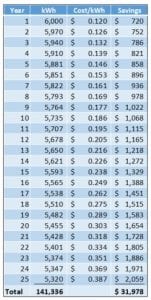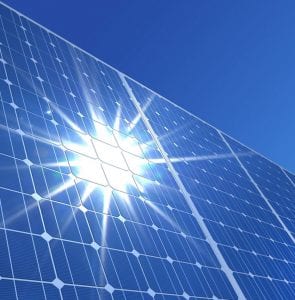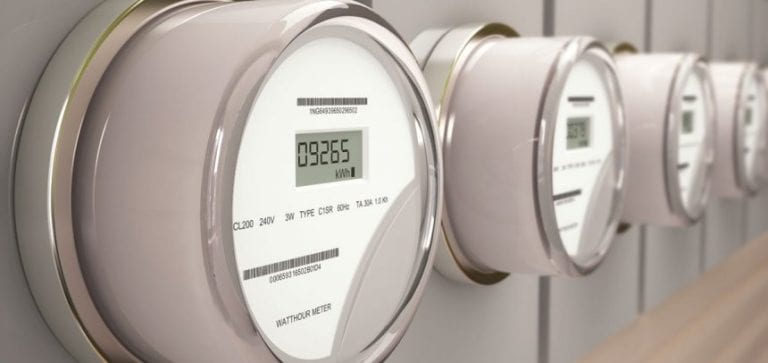10 Questions About Solar (+ 10 more)
A business colleague’s daughter is taking a STEM class at Lutheran High School South, and was tasked with asking an industry professional questions about solar. I thought she did a very nice job of coming up with the set of questions below, and suspect that many people have similar questions.
While each of these questions alone could potentially generate an essay, here’s a fairly quick response and easy read.
- Can I become energy independent by using solar panels at my house?
Yes, but this is challenging. The average home uses 12,000 kilowatt hours (kWh) of energy annually, and you’d need about a 10 kW system (about 40 solar panels, which would take about 750 ft2 of roof space) on your roof to produce that much energy. Ideally, you would deploy a number of energy efficiency and conservation strategies to reduce your usage, so that you’d need a smaller array.
A grid-tied system is the most cost-effective way of storing excess energy produced during the day for use at night. So you’re not completely energy-independent unless you use an off-grid battery-based system, which is much more expensive than the ~$8 monthly service charge for grid service.
- Does Missouri have any large scale solar farms?
As the cost of solar has declined in the past several years, it has become more cost-effective to develop large scale solar farms. Ameren built a 5 megawatt solar farm in O’Fallon – their first utility scale project in Missouri. They are also building a 10 MW solar farm further west just off of I-70 near Montgomery City. Stata Solar developed another 6.4 MW project near Springfield.
- What do you think it will take for people to use more solar?
The growing awareness of the impact of carbon emissions on climate is encouraging people to demand cleaner energy from their utilities. Renewable energy from solar and wind are the predominant forms of clean energy, and solar is accessible to most people.
There are three factors that play into the viability of solar: the amount of sun, the cost of energy, and the financial incentives. As long as you have at least two of the three factors in your favor, like abundant sunshine and high energy prices (California), or high energy prices and strong incentives (Germany), solar will make economic sense. When we had the solar utility rebate in Missouri, we had good sunshine and great incentives to offset our relatively low cost of energy. As the price of energy continues to rise, it makes sense to invest in the fixed cost of solar to levelize your cost of energy over the life of the system.
As the price of solar has declined dramatically in the past 3-4 years, it has become a much more affordable option for both homeowners and businesses. While the financial incentives can further cut the costs significantly, the upfront costs are still an obstacle for many people. However, there are a number of ways to eliminate or minimize the upfront financial barrier:
- Solar leases or power purchase agreements (PPAs) enable a third party to own the solar array on a building, and charge a fixed cost for a monthly lease or a kilowatt hour.
- Many states, including Missouri and Illinois, offer Property Assessed Clean Energy (PACE) programs that will fund the entire cost of a solar project, and authorize the levy of a special property tax assessment over a 10-20 year term to pay back the cost using the surplus from utility bill savings.
- Community solar projects enable renters or homeowners who can’t install solar on their own homes (because of shade or lack of southern exposure) to buy into a portion of a larger array located elsewhere in the community. This enables them to lock into a fixed price for a proportional share of the energy produced from the array.
As solar continues to become more mainstream, we’ll begin to see it more in the open. Right now, many homeowners are still forced to install it in the back of their homes where it can’t be seen from the street. In the future, it’s likely that more people will begin to demand their solar rights.
- Where do you see new innovations in solar energy?
Most solar modules are made of some form of crystalline silicon. While the technology continues to improve overall efficiency levels, it’s essentially the same technology that’s been around for 40+ years. Amorphous silicon, or “thin film” is a more recently developed alternative, and while it’s not yet mainstream, it offers promise to be a cheaper alternative, and could potentially be used as the “skin” of a building. Other cutting edge technologies include fully transparent solar cells that could be used in windows and skylights.
Probably the most significant innovations will come in the way of energy storage. The US Department of Energy and other federal agencies have invested heavily in this technology, and this R&D is benefitting both electric vehicles and storage for intermittent sources of energy like solar and wind. As Tesla moves forward with their Gigafactory, we will continue to see rapid advances in efficiency and corresponding decreases in costs. This will further accelerate the move toward distributed solar.
- Is a solar powered system hard to maintain?
Because there are no moving parts, there’s very little maintenance required on a grid-tied solar array. Depending on soiling conditions, solar modules may need to be cleaned once a year or so to optimize energy production. Central inverters may also need to be occasionally inspected to ensure that they are producing optimally. For the most part, it’s a “set it and forget it” system.
- What is the best renewable source of energy for St. Louis and why?
Right now solar is the best source of renewable energy. St. Louis gets about 4.8 kWh of energy per square meter per day, compared to Miami at around 5.2 kWh/m2/day and Phoenix 6.8. Germany, which leads the world in solar installations, only gets about 3 kWh/m2/day. So we have a relatively good source of solar irradiance.
Many people are interested in utilizing the power of wind, but in St. Louis, we have 8-11 mph winds, and you typically need 12 mph wind speeds in order to justify the cost of a wind turbine. They also require more maintenance, and there are more restrictions to erecting the supporting towers.
Other forms of renewable energy, including biofuels and landfill gas, offer some promise, but are not readily accessible, and our navigable rivers don’t have enough fall to produce hydroelectric power without building huge dams. Lastly, our geography is not conducive to either tidal or geothermal energy.
- How long does it take to break even with the installation cost of a solar system?
When the Missouri utility rebate program was in place, the breakeven point was as little as two years on a commercial solar array. The payback on residential arrays was more like 4-5 years, because they are typically smaller and are not eligible for the tax benefits of depreciation. With only the 30% federal tax credit, the payback is typically around 8-9 years for commercial and 11-12 years for homeowners. But these can vary widely.
- How often should you replace your solar panels?
Most solar panels are warrantied to continue producing power for 25 years. Like LED lamps, solar modules degrade slightly over time – about 0.5% per year. But they will still produce about 80% of their initial output after 25 years of service.
- Is there an effective way to store excess power from the solar panels?
As I mentioned above, the most cost-effective way to store excess energy is on the grid. Bi-directional meters keep track of how much energy is exported to the grid, and how much energy is pulled from the grid. At the end of the billing cycle, the utility customer pays the net difference. If you are a net producer for the month (exports exceed imports), Missouri law says that the utility must pay you their avoided cost (about $0.025/kWh). Illinois customers may carry over any surplus from month to month, with an annual true-up that’s similar to the monthly settlement in Missouri.
Alternatively, batteries can also be used to store surplus energy. However, it’s typically not very cost-effective to have adequate battery capacity to handle peak loads, like cooling a building on a hot summery day. Off-grid users must be very frugal and mindful of their energy use.
Some people have grid-connected systems with batteries available for backup purposes. Again, while decreasing costs continue to make this more affordable, a fossil fuel-powered generator is usually a more cost effective option.
- Who is the world leader in solar technology?
There is really no dominant leader in the solar industry. Solar modules are produced by a wide variety of companies, and manufacturers have to work hard to differentiate their products in what is a highly commoditized market. The inverters that convert the DC power to AC are also made by a relatively broad swath of manufacturers, and consolidation within the industry has resulted in some primary players. There is still enough diversity in the market that I wouldn’t point to anyone as the world leader.
After providing this initial set of answers, another student sent another 10 questions. I was on a roll, so I decided to add these to the list.
10 More Questions About Solar
- How many solar cells are in a solar panel?
Most solar panels (or modules) typically have 60 cells, but there is a growing number of 72 cell modules.
- How durable are solar panels?
Solar panels are designed to withstand the elements, including hail (moderate in size). Most solar companies include a 25 year power production warranty, which guarantees that they won’t degrade more than a fraction of a percent each year.
- Do you have to clean them?
We generally recommend cleaning the modules once a year to optimize the energy production, but it depends largely on soiling conditions. Solar arrays in dusty or pollen-rich areas may require more frequent cleaning, but a good rain will wash away most of the dust and other soiling on modules if they are mounted on a moderate slope. Modules that are mounted at a near-zero degree tilt will have much more soil degradation due to the lack of rainwater runoff.
- How much do solar panels cost?
The solar modules represent the greatest cost of the various components of the array, but they are only a small part of the total installed cost. There are different grades of modules, imported and domestically produced, and there are different types of modules (monocrystalline silicon modules are more expensive than polycrystalline.) Modules are priced based on their power capacity, and are typically priced on a per watt basis. For example, a single 250 watt module that costs $0.80/watt would cost $200. The inverters, racking, and other materials (like wire, conduit, and electrical boxes) would add another $.60+/W to the price. The labor required to engineer and install the system would typically cost $1.20/W, but there are economies of scale that factor into the mix. Finally, the solar company would have to cover their taxes, permitting, overhead and profit, which would add another $1/W. So, the total installed price of $3.60 per watt on a 5 kilowatt system would be $18,000. Financial incentives vary from state to state, but the 30% federal tax credit would reduce this cost to $12,600. The $2/W Missouri solar utility rebate, which has now been exhausted, reduced this by an additional $10,000 (though this is taxable income.)
- How are solar cells made?
 A pure silicon ingot is formed by inserting a silicon “seed” in molten silicon. Here’s a video that shows the details. Once the cylindrical ingots have cooled, the ingot is then sliced into thin wafers, and the rounded sides are shaved off to form a square with only the rounded corners remaining (see right). The wafers are then “doped” with boron and phosphorous to enable the photovoltaic effect. Tiny electrical conductors are then attached to the wafers to carry electrons generated in the photovoltaic process. More details are available here.
A pure silicon ingot is formed by inserting a silicon “seed” in molten silicon. Here’s a video that shows the details. Once the cylindrical ingots have cooled, the ingot is then sliced into thin wafers, and the rounded sides are shaved off to form a square with only the rounded corners remaining (see right). The wafers are then “doped” with boron and phosphorous to enable the photovoltaic effect. Tiny electrical conductors are then attached to the wafers to carry electrons generated in the photovoltaic process. More details are available here.
- How do you determine how big of a system you will need for your house?
You first look at the last 12 months of utility bills to understand historic electricity usage. A more thorough analysis will include 24 months to confirm trends or identify anomalies. In many cases, the available unshaded roof space may be a constraint. The system is then sized to generate as much power as possible, while minimizing monthly overages, because the production and demand curves will not be equal. (Net metering will enable you to store energy on the grid during the billing cycle, but any excess production at the end of the month will be purchased at the utility’s avoided cost.)
- Which would be better – if you roof-mounted your solar panels or ground-mounted them?
Roof-mounted arrays are more popular because they are typically less expensive and do not require any additional land space. However, the slope and orientation of a roof are not always ideal. A ground-mounted array requires concrete footings and more expensive racking, but the tilt and orientation can be adjusted to optimize energy production (30° tilt facing due south). Roof mounted modules will have to be removed before the roof can be replaced, which adds a significant cost to a new roof. Ground-mounted arrays require a fence around them if the array is not at least 8’ off the ground to minimize any tampering, further adding to the cost.
- How much money would a house save if they switched to solar panels?
 This depends on the size of the array, of course, as well as the cost of energy. The typical residential customer pays around $0.12/kWh after all of the surcharges and taxes are considered. So if your 5 kW array produces 6,000 kWh, you’ll save $720 the first year. However, as the cost of energy continues to rise (at an average of 5% annually) the savings grow over time, with lifetime savings of nearly $32,000. This assumes an annual degradation in the solar array of 0.5%.
This depends on the size of the array, of course, as well as the cost of energy. The typical residential customer pays around $0.12/kWh after all of the surcharges and taxes are considered. So if your 5 kW array produces 6,000 kWh, you’ll save $720 the first year. However, as the cost of energy continues to rise (at an average of 5% annually) the savings grow over time, with lifetime savings of nearly $32,000. This assumes an annual degradation in the solar array of 0.5%.
Another way to look at this is to take the net cost of the system after incentives and divide that by the total kWh that it is warrantied to produce in its lifetime. So the net cost of $12,600/141,336 kWh lifetime production would result in a fixed (or levelized) cost of just under $0.09/kWh, which is less than you’re currently paying for grid power in year 1, and fixed for the life of the system!
- How long does it take to install a solar panel system in a home?
A small residential system can be installed in a single day. A larger or more complicated installation may take 2 or 3 days.
- Who installs a solar panel system?
Only licensed electricians should install the solar array. It is possible to have roofers or other general contractors install the racking, but all electrical components should only be installed by a qualified electrical professional.


